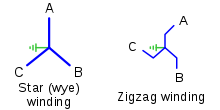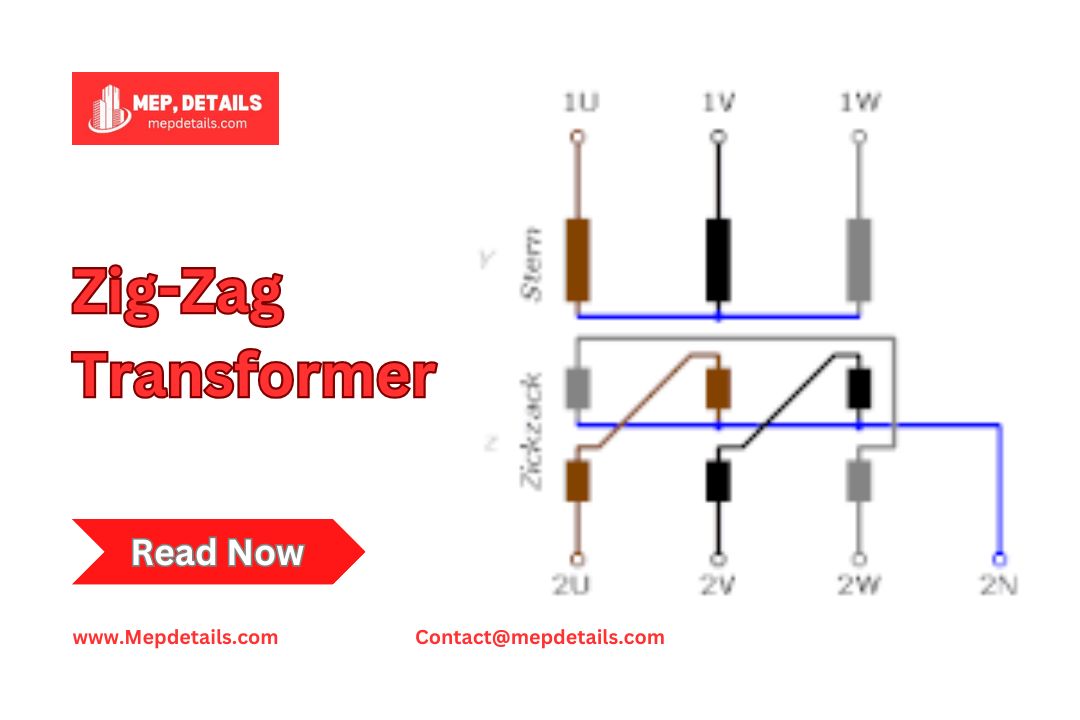Transformers are essential in modern infrastructure because they help move electrical energy between circuits through electromagnetic induction. They adjust voltage levels, which is important for distributing electricity and transmitting power. In this article, we’ll look at the zig-zag transformer, a unique type of transformer.
What is a Zig-Zag Transformer?

A zig-zag transformer, also called the “interconnected star winding,” is a special transformer built to manage unbalanced loads and offer a neutral connection in three-phase power systems. It connects three single-phase transformers in a zig-zag pattern to create a virtual neutral point for the system. This design is especially helpful in systems where a neutral connection is hard to access or where unbalanced loads often occur. The zig-zag transformer also reduces harmonic distortion and offers ground fault protection. It is commonly used in industrial and commercial setups that need reliable and stable power systems.
Zig-Zag Transformer Winding Connections Explained
The zig-zag transformer uses a unique setup with six coils: three outer coils (ZIG windings) and three inner coils (ZAG windings). In its star-shaped connection, each outer coil connects to the inner coil of the next phase, creating a series link. This star design helps match voltages by using the same number of turns in each phase but with opposite winding directions. The inner coil terminals connect to the neutral point, which lets zero-sequence currents flow.
In detail, phase ‘a’s outer coil connects to phase ‘b’s inner coil, phase ‘b’s outer coil connects to phase ‘c’s inner coil, and phase ‘c’s outer coil connects to phase ‘a’s inner coil. This setup creates a 30-degree phase shift between the zig winding and the line-to-neutral voltage. The zig-zag transformer needs about 15.47% more turns than standard transformers to reach the same voltage levels. Although this design works well for specific uses, it costs more due to the extra turns required.
Zig-Zag Transformer Applications
Grounding Transformer
The zig-zag transformers serve as grounding transformers in power systems, providing a clear path for zero-sequence currents when the system is unbalanced or when faults occur. They direct these currents away from the primary windings, helping keep the system stable and protecting equipment. This makes power systems safer for both infrastructure and workers. Their ability to handle ground faults makes zig-zag transformers essential for power distribution systems that need strong grounding.
Power Electronic Converters
Zig-Zag transformers improve the performance of power electronic converters and reduce harmonic distortions. Their unique design helps control harmonics, leading to better power quality. By creating a more stable and balanced output, zig-zag transformers boost the efficiency and reliability of devices like variable speed drives, renewable energy systems, and other electronic power controls.
Earthing Reference or Earthing Transformer
Zig-Zag transformers act as earthing references in power systems, especially where a clear earth reference is essential. They connect the inner coil terminals to the neutral and ground the outer coil, establishing a stable grounding point. This prevents floating grounds and improves the system’s safety and reliability. Using zig-zag transformers in this way keeps voltage consistent and lowers the risk of equipment damage from electrical faults.
Conclusion
Zig-Zag transformers play an important role in managing unbalanced loads, reducing harmonic distortion, and providing a reliable neutral connection in three-phase systems. Their unique winding design supports efficient grounding, improves power quality, and ensures system stability. Commonly used in industrial and commercial settings, zig-zag transformers enhance safety and performance by creating a stable earthing reference and minimizing fault risks. Whether grounding power systems or improving electronic converter efficiency, zig-zag transformers offer versatile solutions for stable and balanced power distribution.
FAQs
What does a zigzag transformer do?
A zigzag transformer grounds an ungrounded 3-phase system by creating a neutral connection, which connects to an earth reference point. It also helps reduce harmonics by suppressing certain harmonic currents, like the 3rd, 9th, 15th, and so on.
What is a delta zigzag transformer?
A Delta zig-zag Transformer, like those by Medipower, provides isolation between the ground and system components in distribution systems. It offers better grounding compared to traditional Delta-Wye transformers
How does a zigzag transformer reduce harmonics?
The transformer has a delta connection on the primary side and a special zigzag winding on the secondary side. This zigzag winding cancels out harmonic currents, like the 3rd, 9th, and 15th, making the system more stable.
What is the zigzag voltage?
The zigzag voltage is the combined voltage of the windings “Aa” and “Na.” For example, if winding A1N1 has two turns, and Aa and aN each have W turns, the voltage AN is the sum of the voltages in Aa and Na.
Read More – Eddy Current Theory and Applications
